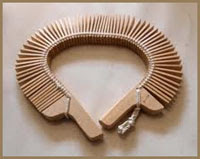:::::::::::::::::::::::::::::::::::::::::::::::::::::::::::::::::::::::::::::::::::::::::::::::::::
Waka Festival (Waka matsuri)
***** Location: Wakanoura
***** Season: Early Summer
***** Category: Observance
*****************************
Explanation
Waka matsuri 和歌祭 (わかまつり) Waka festival
Wakanoura matsuri 和歌浦祭(わかのうらまつり)
. Wakanoura festival
saiga matsuri 雑賀祭(さいがまつり) Saiga festival
saiga odori 雑賀踊(さいがおどり) Saiga dance
(Wakanoura is spelled in various ways,
in Japanese and in English.)
The samurai from Saiga / Saika (Saiga shuu, Saika shuu 雑賀衆, 雑賀惣国) where a group which had introduced the use of guns very early. Their fighting groups, often not more than 50 gunmen divided in two groups of 25, shooting one after another, while the other group loaded the guns again, they were able to withstand the onslaught of larger armies of Nobunaga and Hideyoshi, who finally pardoned them because he could not win against them.
They lead a rather free group life and decided everything after a democratic discussion..

source : wikipedia
The most famous of their armsmen was Saiga Magoichi - Saika Magoichi 雑賀孫市 / 孫一
the leader of the Saika Renegades, rebels who opposed Nobunaga's rise to power with Kennyo Honganji. After Kennyo's surrender, Magoichi allegedly fought at Sekigahara, and even managed to shoot Hideyoshi in the leg. Later became a mendicant monk, and obtained a government post in the Mito Domain.
The real Magoichi's name and his history are unclear, but there are some regions to claim his grave and his descendants are alive to this day.
:::::::::::::::::::::::::::::::::::::::::::::::::::::::::::::::::::::::::::::::::::::::::::::::::::
The main festival at the shrine Toshogu in Wakanoura.
Middle of May on a saturday or sunday.
紀州東照宮 Kishu Toshogu Shrine
. . . CLICK here for Photos !
The main deity of this shrine is Tokugawa Ieyasu, founder of the Tokugawa Bakufu, Edo government.
The founder of the Tokugawa clan in Kishu, Wakayama, Tokugawa Yorinobu, built this shrine to honor his father Ieyasu.
Early in the morning prayers and ritual dances (bugaku, dengaku) were performed in the shrine. In the after noon, the mikoshi palanquin was carried to Suzaki beach 須崎.
Everyone could be at the beach, watch the procession and celebrate. Ritual sumo wrestling was also performed. Other dances, like Mochibana dance, are performed.

source : Wakayama screens Museum
The Saiga dance is especially famous.
Men dressed in samurai attire, rattling bamboo sasara rattles and lift one leg high in the air. It is said to represent the gunmen when walking in the woods and preparing for battle.
sasara dance ささら踊り/ 笹羅踊
source : 雑賀踊の成立
.................................................................................

Wakayama Prefecture is located in the Kinki Region of the island of Honshu, Japan.
The capital is at Wakayama City.
Located in the southwestern part of Wakayama City,
Wakanoura has been considered a scenic area since the old days. It is well-known as a place visited by many members of the Imperial family and poets who wrote poems of this beautiful land.
It was even featured in Manyoshu, the country's oldest anthology of poems written between late 7th and late 8th centuries. In the area, you will find many historic buildings and structures such as the shrine called Tamatsushima Jinja that symbolizes Wakanoura, the monument at Wakanoura Tenmangu where the god of learning Sugawara-no-Michizane is enshrined,
and Kishu Toshogu designated as an important cultural asset.
On the grounds of the Tamatsushima Jinja are monuments of Akanohito Yamabe and Basho Matsuo who both are famous poets. Yosuien, a Daimyo garden that took eight years to build from 1818, is also one of the places of interest. Wakanoura is indeed an area you would want to slowly look around while thinking of the times of Manyoshu.
source : www.japan-i.jp
*****************************
Worldwide use
*****************************
Things found on the way
. Tosho-Gu Shrine in Nikko 日光の東照宮 .
and Tokugawa Ieyasu 徳川家康
*****************************
HAIKU

at Wakanoura, in front of shrine Tamatsushima Jinja
和歌山市和歌浦・玉津島神社前
行く春に和歌の浦にて追ひ付きたり
yuku haru ni Wakanoura nite oitsukitari
departing spring:
I've finally caught up with it
here at Wakanoura
Tr. Barnhill
at the end of spring
here at Wakanoura
I have finally caught up (with spring)
quote
(There is no cut marker at the end of line 1 in Japanese.)
. Matsuo Basho 松尾芭蕉 Archives of the WKD .
:::::::::::::::::::::::::::::::::::::::::::::::::::::::::::::::::::::::::::::::::::::::::::::::::::::

sasara instrument ささら / 簓
初蝉は雑賀踊りのささらかな
hatsu semi wa saiga odori no sasara kana
this first cicada
sounds like the rattle
at the Saiga dance
Shun Koo 春耕
:::::::::::::::::::::::::::::::::::::::::::::::::::::::::::::::::::::::::::::::::::::::::::::::::::::
Haiku about Wakanoura
行春にわかの浦にて追付たり
yuku haru ni Waka no Ura nite oitsuketari
The passage of spring
at Waka Bay
have I found, indeed.
Tr. Thomas McAuley
source : dmitrismirnov
:::::::::::::::::::::::::::::::::::::::::::::::::::::::::::::::::::::::::::::::::::::::::::::::::::::
掃溜に鶴の下りけり和歌の浦
hakidame ni tsuru no ori keri waka no ura
cranes land
on the rubbish heap...
Waka-no-Ura
Kobayashi Issa
Tr. David Lanoue
:::::::::::::::::::::::::::::::::::::::::::::::::::::::::::::::::::::::::::::::::::::::::::::::::::::
涼しさや蚊帳の中より和歌の浦
suzushiza ya kaya no naka yori Wakanoura
this coolness -
from inside the mosquito net
(I look at) Wakanoura
Natsume Soseki 夏目漱石
1911, August 14th, Soseki 45

source : agara no wakayama
Stone memorial at Wakaura Park わかうら園
*****************************
Related words
***** . Placenames used in Haiku - LIST .
BACK : Top of this Saijiki
[ . BACK to WORLDKIGO . TOP . ]
:::::::::::::::::::::::::::::::::::::::::::::::::::::::::::::::::::::::::::::::::::::::::::::::::::::






1 comment:
Susaki Jinja 洲崎神社 (Sunosaki Jinja)
Chiba
.
https://japanshrinestemples.blogspot.jp/2017/01/kaitei-underwater-shrine-and-susaki.html
.
Post a Comment